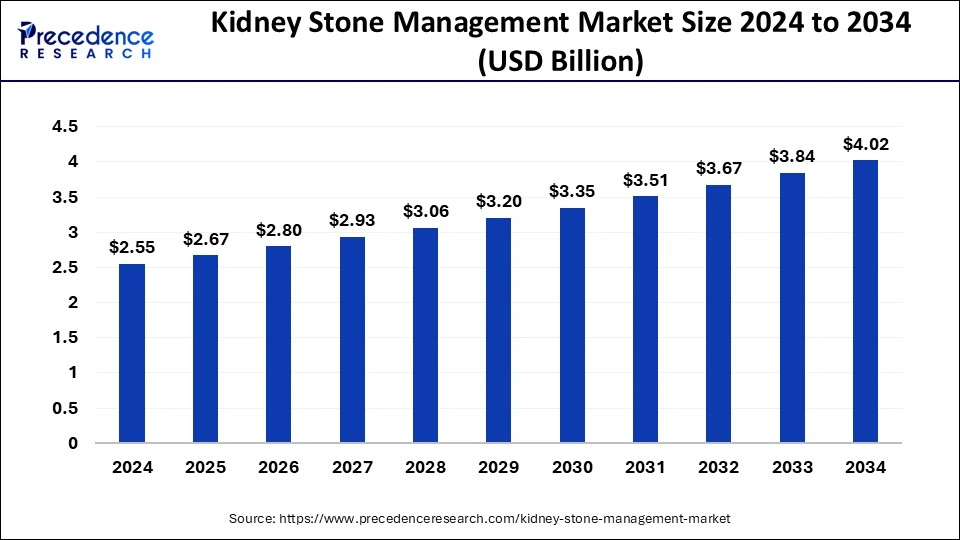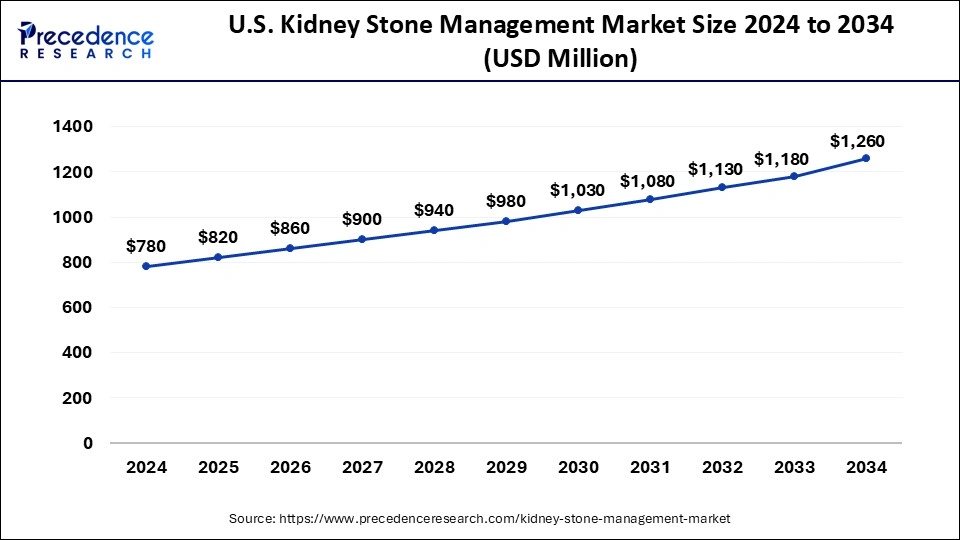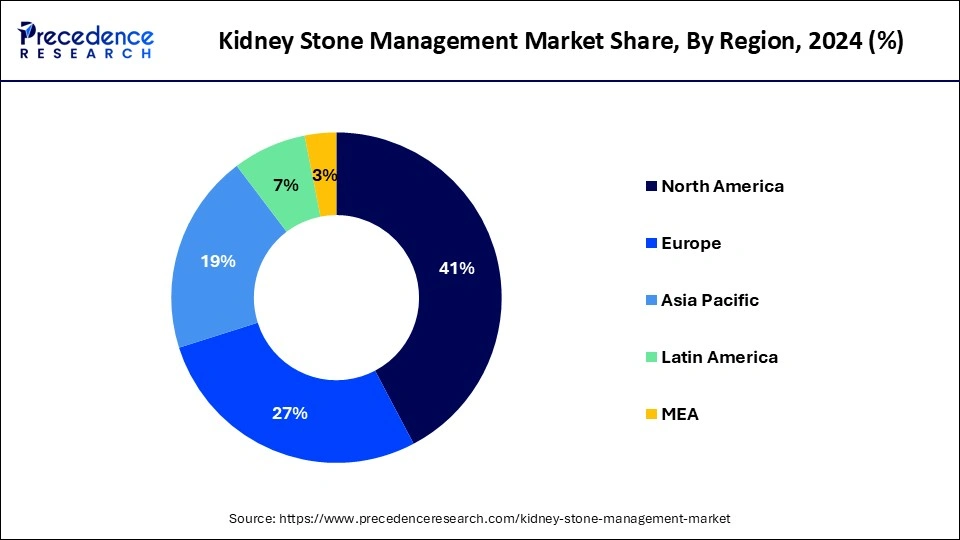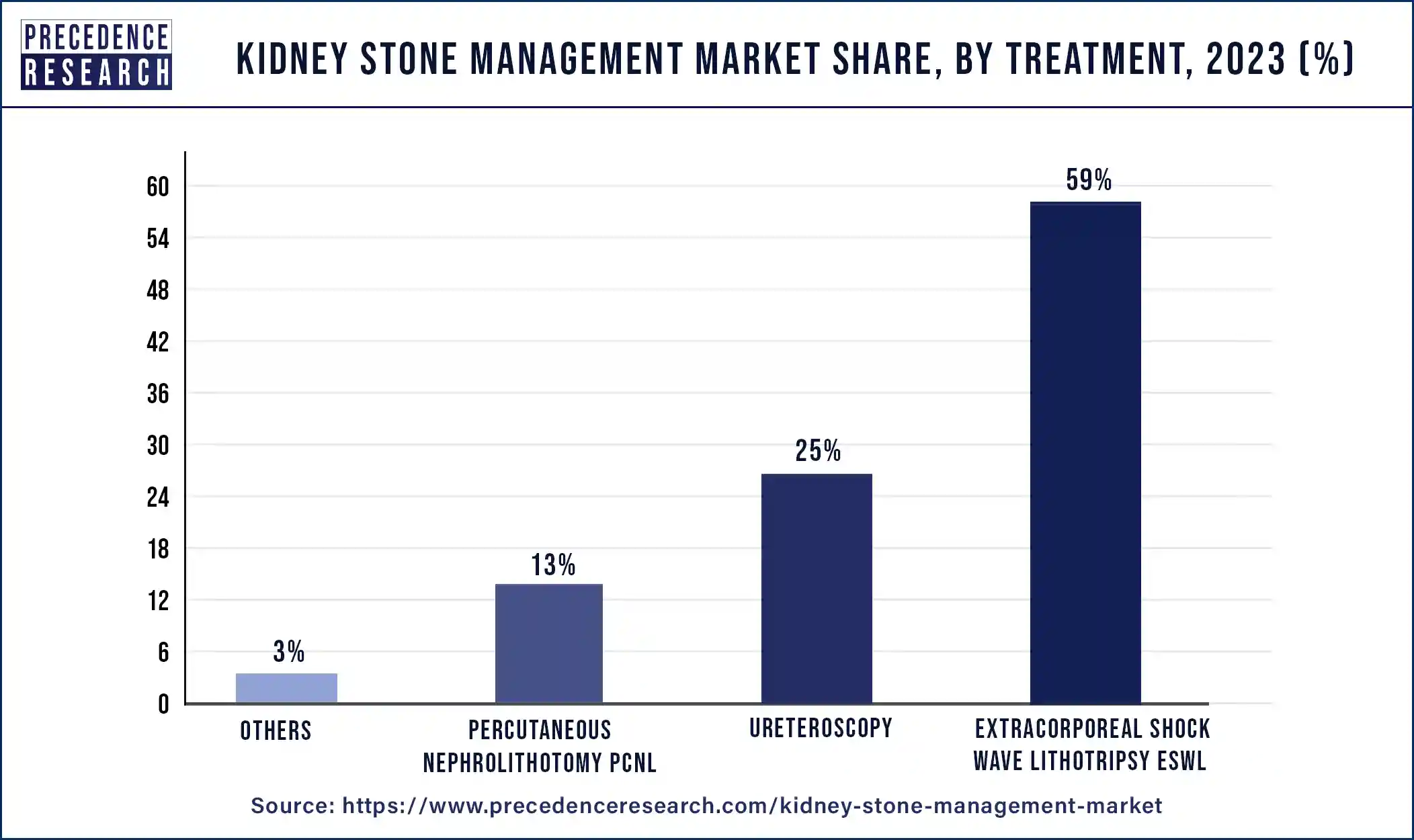January 2025
The global kidney stone management market size accounted for USD 2.67 billion in 2025 and is forecasted to hit around USD 4.02 billion by 2034, representing a CAGR of 4.65% from 2025 to 2034. The North America market size was estimated at USD 1.05 billion in 2024 and is expanding at a CAGR of 4.75% during the forecast period. The market sizing and forecasts are revenue-based (USD Million/Billion), with 2024 as the base year.
The global kidney stone management market size accounted for USD 2.55 billion in 2024 and is predicted to increase from USD 2.67 billion in 2025 to approximately USD 4.02 billion by 2034, expanding at a CAGR of 4.65% from 2025 to 2034. Rising cases of kidney stones worldwide due to the modern sedentary lifestyle and excessive intake of minerals and salt-based diet among the population are major drivers of the market globally.

The U.S. kidney stone management market size was evaluated at USD 780 million in 2024 and is projected to be worth around USD 1,020 million by 2034, growing at a CAGR of 4.91% from 2025 to 2034.

North America dominated the kidney stone management market globally in the previous year of 2024. The region is popular for its novel technologies and research centers with world-class medical facilities, institutions, and effective procedures to remove kidney stones with minimal invasion in the human system, leading to lesser damage of healthy cells in the body that would not be achievable otherwise by conventional surgery practices by professionals. Country-wise, unites states has an exceptionally advanced healthcare system facilitated by a robust infrastructure.
The US has pharmaceutical companies that are highly engaging in the research and development of cutting-edge technologies that can be integrated with the healthcare system to reduce the possible improved diagnostic tools effectiveness and outcome of kidney stone removal procedures can be enhanced. Consequently, healthcare providers acknowledge this rising demand and have started offering a wide range of customized services with advanced treatments, which is attracting patients to the North American healthcare system and further driving the growth of the kidney stone management market on a global level.

Asia Pacific is an expanding market, and it is projected to hold the largest share of the kidney stone management market, with an estimated revenue share of 36% by the end of 2034. The geriatric population and age-related health concerns, including kidney-related dysfunctionalities, are prominent drivers of the Asia Pacific market. Such a rising trend increases the demand for effective management strategies fabricated with the particular needs of individuals suffering from kidney diseases, which could be fatal in the long run.
Technological advancements play an essential role in driving the Asian Pacific market. The region has numerous innovative technologies that offer precise and effective treatment. The integration of robotic assistance with advanced tools is crucial to managing kidney stone procedures and enhancing the capabilities of the healthcare sector.
The kidney stone management market is witnessing significant growth due to the rising prevalence of kidney stones worldwide. A kidney stone is also known as renal calculus.it is a complex, crystalline mineral material formed within the kidney or urinary tract. These stones can cause severe pain and discomfort, which has led to an increased demand for effective and innovative solutions for kidney stone management.
Despite the availability of advanced treatment options, the high costs associated with kidney stone management procedures can be a highly impeding market restraint. The expenses involved in surgeries, hospital stays, and post-operative care can financially burden patients, particularly in developing countries with limited healthcare resources.
The kidney stone management market is driven by factors such as the increasing prevalence of kidney stones, advancements in medical technology, and the aging population. However, high treatment costs and a need for more awareness act as restraints on market growth. Opportunities exist in the demand for non-invasive procedures, the adoption of ESWL, and technological advancements in stone retrieval devices. As the global burden of kidney stones continues to rise, the market is poised for further growth and innovation in the coming years.
| Report Coverage | Details |
| Growth Rate from 2025 to 2034 | CAGR of 4.65% |
| Market Size in 2025 | USD 2.67 Billion |
| Market Size by 2034 | USD 4.02 Billion |
| Largest Market | North America |
| Base Year | 2024 |
| Forecast Period | 2025 to 2034 |
| Segments Covered | Type of Stone, Diagnostics Method, Treatment, and End-use |
| Regions Covered | North America, Europe, Asia-Pacific, Latin America, and Middle East & Africa |
Increasing prevalence of kidney stone
The primary driver for the kidney stone management market is the growing prevalence of kidney stones globally. Factors such as a sedentary lifestyle, poor diet choices, and increased obesity rates have contributed to the rise in kidney stone cases. The increasing number of patients seeking medical intervention to manage kidney stones has created a growing market for innovative and efficient treatment options.
The global aging population is another significant reason for the kidney stone management market. Older individuals are more susceptible to developing kidney stones due to age-related kidney and urinary system changes. The increasing number of elderly individuals worldwide is expected to drive the demand for kidney stone management solutions.
Lack of awareness among the population
A major restraint for the kidney stone management market is the need for more awareness about kidney stones and their management. Many individuals may need to be aware of the symptoms, risk factors, and available treatment options. This leads to delayed diagnosis and treatment, affecting market growth. Educational campaigns and awareness programs are essential to overcome this restraint and improve patient outcomes.
Growing demand for non-invasive medical procedures
There is a growing demand for non-invasive or minimally invasive procedures for kidney stone management. These procedures offer several advantages over traditional open surgeries, such as reduced pain, shorter hospital stays, and faster recovery times. Innovative techniques like laser lithotripsy, percutaneous nephrolithotomy (PCNL), and robotic-assisted surgeries provide immense opportunities for market growth.
ESWL is a well-established method for kidney stone management and is widely adopted globally. This non-invasive procedure uses shock waves to break down kidney stones into smaller pieces, making them easier to pass through urine. The increasing adoption of ESWL, especially in developing countries, presents significant growth opportunities for the kidney stone management market.
The calcium oxalate segment held the largest share in the market in 2024. Hence, kidney stone management mainly consists of calcium oxalate. Followed by struvite, uric acid, and cysteine-type stones, nearly 75% of kidney stones are formed by calcium oxalate deposition. A diet with higher levels of sugar, oxalate, and protein is the primary reason for a kidney stone of oxalate.
The risk factors that come along with such a type of kidney stone are obesity, cardiovascular triggers, and other underdiagnosed medical conditions that could lead to an exacerbation of kidney disease. The rising prevalence of digestive disorders due to the sedentary lifestyle of modern days comes with fat saturation on the main functioning body parts among the population, which is the driver of the kidney stone management market—and stimulating its further growth on a global scale.
The ultrasound segment held a significant share in the market in 2024. Ultrasound is a widely used imaging method to diagnose kidney stones, followed by abdominal MRI, X-RAY, and computed tomography methods. As the name suggests, ultra-sound is a method where sound waves are used to detect kidney stones without exposure to radiation that might be harmful to the human system.
Ultrasound is the only method considered safe for young people and pregnant ladies, and the European Association of Urology also recommends it as a first-line diagnostic technology. That's why many radiologists preferentially use an ultrasound method, which drives the market. Additionally, this technology can be safely used on children precisely due to their small body structure. Eventually, ultrasound will be the segment driving the kidney stone management market with considerable shareholdings on a broader scale, stimulating the further expansion of the market across various regions.
The extracorporeal shock wave lithotripsy ESWL segment held the largest share of 59% in 2024 and dominated the kidney stone management market globally. ESWL holds the largest market share due to its non-invasive nature and wide availability. They are making it a preferred choice of physicians for treating kidney stones. The procedure involves using shock waves to break down the stones into smaller fragments, which are then passed out of the body through urine. Extracorporeal shock wave lithotripsy uses generated acoustic or sound waves which damage stones due to the effects of direct stresses and cavitation done on the target area.

Generally, ESWL treatment is less painful than conventional surgeries that require anesthesia before procedure. These devices are being modified to generating a pulses of shock wave from electromagnetic and piezoelectric sources to break down a stone with immensely focused intensity. Hence, ESWL's effectiveness, minimal complications, and shorter recovery times contribute to its prominence in the market.
The hospitals segment held the largest market share and dominated the kidney stone management market. The market is divided by end-users, including hospitals, specialty clinics, ambulatory surgical centers, and others. This segment is witnessing a rise in kidney stone patients and hospitals adopting advanced technology. Hospitals provide satisfactory reimbursement to patients. That is also another major driver of growth in this segment.
After the hospital segment, the specialty clinics segment is expected to experience the highest growth rate over the forecast period. They are currently the fastest-growing segment in the global market, followed by the hospitals segment. The specialty clinics segment will see a rise in skilled surgeons and favorable reimbursement policies available for patients.
By Type of Stone
By Diagnostics Method
By Treatment
By End-use
By Geography
For inquiries regarding discounts, bulk purchases, or customization requests, please contact us at sales@precedenceresearch.com
No cookie-cutter, only authentic analysis – take the 1st step to become a Precedence Research client
January 2025
August 2024
December 2024
April 2025